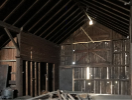Campus News
Studio envisions Richardson barn as ‘bottle to barn’ establishment

The existing barn on the edge of the Richardson Olmsted Campus is envisioned as a destination for locally sourced food and beverage. Photo by Siera Rogers
By TYLER MADELL
Published February 24, 2020 This content is archived.
Students in a graduate preservation planning studio have completed an adaptive reuse proposal for a 19th-century barn located on the historic Richardson Olmsted Campus in Buffalo.
The interdisciplinary studio, directed by Kerry Traynor, clinical associate professor of urban planning, School of Architecture and Planning, engaged students across urban planning, historic preservation and real estate development. The focus of their analysis was a 9,000-square-foot barn building that served the original Buffalo State Hospital, designed in 1870 by architect H.H. Richardson.
The barn, constructed in 1928 from repurposed barn timbers and materials, was an integral part of the design of the hospital campus, which was inspired by the Kirkbride Plan, a design plan advocated by Philadelphia psychiatrist Thomas Kirkbride that emphasized ample light, restorative surroundings and work therapy as treatment for patients.

The students propose converting the barn into “Board and Batten,” a destination for locally sourced food and drink.
Students drew from this history — and the Richardson Olmsted Campus’s current rebirth as an urban resort — in shaping their recommendations for the barn’s reuse as a destination for locally sourced food and drink. The “Board and Batten” restaurant and bar is billed as a “bottle to barn” establishment featuring a tasting room for locally sourced wine, spirits and beer. Adjacent to the bar/restaurant would be a home goods store and a specialty tea, oil and vinegar boutique.
Students’ recommendations stress reintegration of the barn with the rest of the campus, leveraging the Frederick Law Olmsted-designed historic green spaces that were integral to the Kirkbride Plan as a network of pedestrian paths, space for an organic farm and restored water features.
A feasibility study determined the project could be supported with the use of federal and state historic tax credits, a federal grant for roof repairs, conventional financing and minimal developer equity. Students also conducted a market analysis, assessed existing nearby amenities and considered integration with the current uses of the Richardson buildings, which house the Hotel Henry and the Buffalo Architectural Center.
While past decisions by planners and developers have contributed to the breakup of the original plan for the Richardson Olmsted Campus, students say their work aims to integrate historic elements into new uses that celebrate the Kirkbride and Olmsted legacies.






